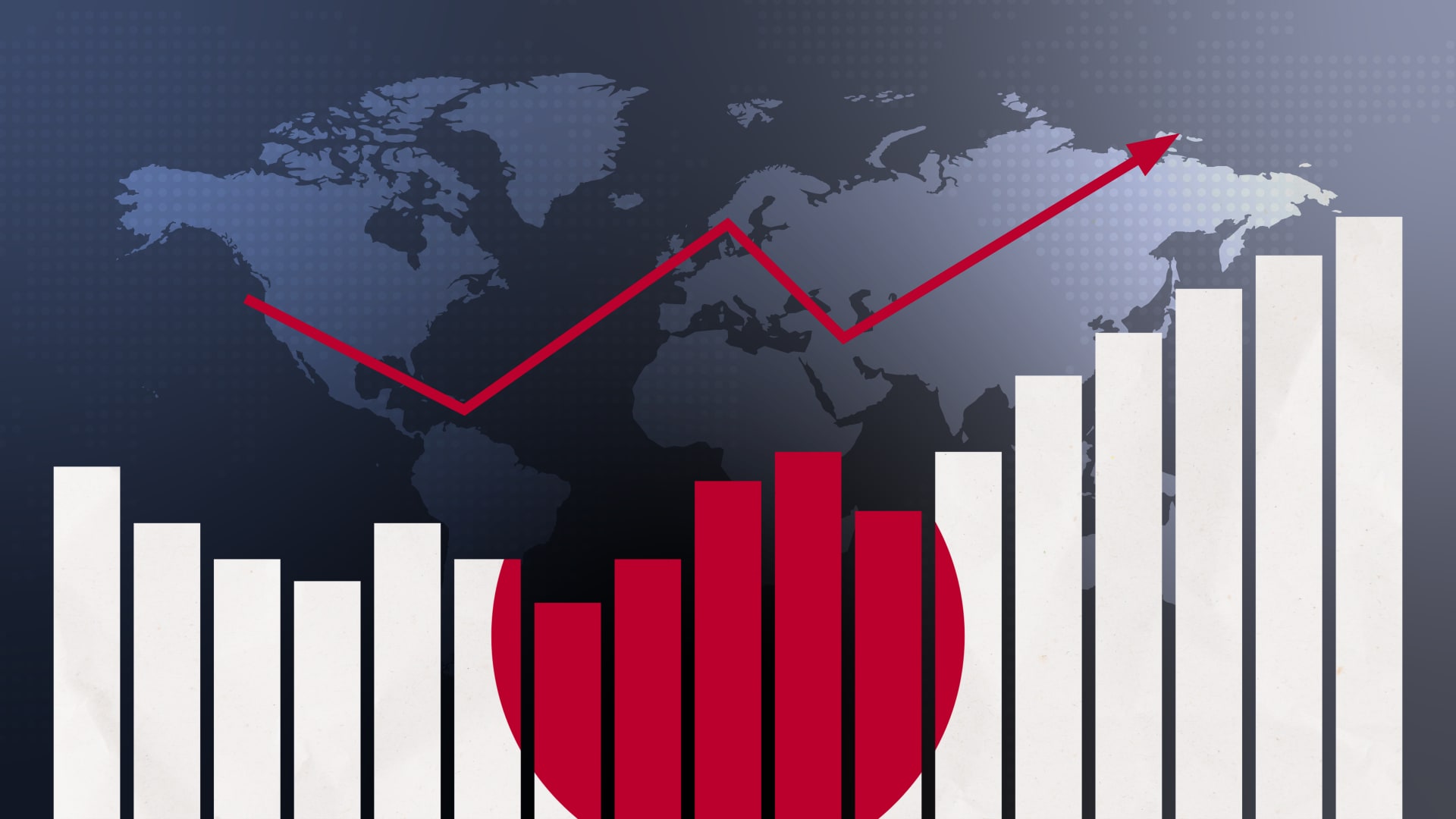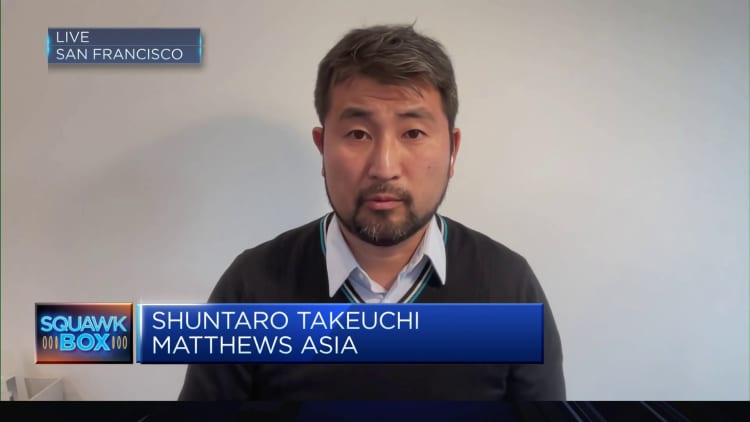
Japan bar chart graph with ups and downs, increasing values, concept of economic recovery and business improving, businesses reopen, politics concept with flag
Elif Bayraktar | Istock | Getty Images
Speculation is swirling that the Bank of Japan may move to exit the world’s last negative rate policy as early as next week, when policymakers gather for their March meeting.
To be clear, most analysts expect Japan’s first rate hike since 2007 to take place in April after policymakers have more evidence of a meaningful wage increase following the “shunto” annual spring negotiations between unions and employers later this week.
“We continue to expect that the BOJ will terminate NIRP in April,” Goldman Sachs economists led by Tomohiro Ota wrote in a Tuesday note, referring to the negative interest rate policy. “While a March rate hike cannot be ruled out, we believe that the BOJ’s communications at this juncture are not clear enough to justify assuming the March hike as the base case scenario.”
“By postponing the rate hike decision just for a month, the BOJ can collect more data, can obtain an opportunity to explain their views behind the major policy change through the quarterly Economic Outlook report, and can avoid a rate hike just before fiscal year end when many financial institutions close their books,” they added.
While BOJ Governor Kazuo Ueda meets with his other eight board members eight times a year, the central bank updates its economic outlook only four times: in January, April, July and October. The BOJ’s next meeting is March 18-19.
Despite “core core inflation” — which excludes food and energy prices — exceeding its 2% target for more than a year, the BOJ has barely budged from its current ultra-accommodative monetary policy posture that has been in place in 2016.
While the central bank has effectively loosened its yield curve control policy over longer term interest rates over the past 16 months, it has kept interest rates at -0.1% and still maintains an upper limit for 10-year Japanese government bond yield at 1% as a reference.
The yield curve control is a policy tool where the BOJ targets an interest rate, and then buys and sells bonds as necessary to achieve that target.
Other than the YCC, Japan has also engaged in unconventional policy experimentation for decades with asset buying and quantitative easing in its bid to lift the world’s fourth-largest economy out of deflation.
“The Bank of Japan has no right to keep monetary policy where [they are now]. The economy is not in any shape or form to have that ultra-loose monetary policy and quantitative easing, which we have been calling a major policy error,” Amir Anvarzadeh, a market strategist at Asymmetric Advisors, told CNBC Tuesday.
Japan, now the world’s fourth-largest economy, narrowly avoided a technical recession in revised GDP print released Monday, which showed private consumption contracted for a third quarter in a row.
Inflation blues
High inflation is crimping domestic demand and private consumption, underscoring the fragility of growth in Japan. Private consumption fell 0.3% quarter on quarter — more than the provisional estimates of a 0.2% decline, according to the final GDP data released Monday.
In fact, it was largely due to strength in capital expenditure that Japan managed to avert a technical recession. Still, upward revisions were weaker than expected.
“Inflation in Japan is being underestimated,” said Anvarzadeh, adding that government subsidies — which tentatively expire in April — have kept inflation “artificially low.”
“But once they do expire, inflation will be even higher,” he added.

Ueda has repeatedly indicated imported cost pressures from high energy prices in the post-Covid period were likely driving price increases in Japan, and he is looking for evidence of organic cost pressures.
The central bank believes wage increments would translate into a more meaningful spiral, encouraging consumers to spend.
“Cost-push inflation is inflation, regardless of what you might think. What do you think it’s everywhere else?” said Anvarzadeh. “The big fallacy is that in the last 20 years, it was that deflation that hurt consumption.”
“Actually, deflation helped consumption in Japan because wages were stagnating, prices were falling and thus, consumption held up. And now, wages are going up, and now inflation’s still rising ahead of that and consumption has been hurt,” he added.
Market repositioning
After some recent hawkish comments from BOJ officials, Japan narrowly averting a technical recession and hopes rising for robust wage gains, some market repositioning has kicked into gear as investors brace themselves for a possible BOJ move in March.
Bank of America’s economists on Tuesday brought forward their base case for a BOJ negative rate exit at next week’s meeting, instead of their previous forecast for April — underscoring the widening schism in market views.

The rally in Japanese equities has grounded to a halt, with the yen strengthening against the dollar and 10-year Japanese government bond yields hitting their highest in three months Tuesday.
BOJ governor Ueda appeared to temper expectations Tuesday, striking a relatively more pessimistic tone on the Japanese economy than two months ago in comments to Japan’s parliament.
Also Tuesday, Finance Minister Shunichi Suzuki said Japan was not at a stage where it could declare deflation as beaten, Reuters reported.
‘Time is right for wage increase’
Shunto wage negotiations will finish Wednesday, with the first tally of negotiated outcomes available from Friday. Japan’s biggest trade union grouping Rengo said workers at major firms have asked for annual increases of 5.85%, exceeding the 5% level for the first time in three decades.
If so, that would top the more than 3% increases achieved last year, which were the biggest increase in about three decades.

“Compared to other years, [they are] much more open in terms of increased wages… because over the past decade, what’s noticeable is that corporate Japan has been raking up profits and the profit margins are already at record high levels and on top of that, with the shortage of labor itself, the time is right for wage increase,” Shuntaro Takeuchi, a Japan fund manager at Matthews Asia, told CNBC Wednesday.
“This year, most of the corporates — a lot of the corporates — are starting to actually announce more wage hikes even higher than [5%], based on some sectors. I think they are more proactive than last year, so I wouldn’t be surprised if it lands somewhere between 3% and 5%,” he added.
What would an exit look like?
Many market participants are looking beyond the timing of BOJ’s policy change.
“BOJ Governor Ueda said at the press conference after the January [monetary policy meeting] that the monetary policy environment will remain extremely easy for the time being, implying that subsequent rate hikes would be very modest,” Goldman Sachs economists said.
“Whether the BOJ mentions the future path in the policy statement in a bid to limit excessive rate hike expectations and accompanying risk of interest rate rises, or whether it will only use ambiguous language in order to prioritize flexibility in policy to address inflation risks in the future will be important to gauge the order of the BOJ’s monetary policy priorities,” they added.
Reuters reported that if the BOJ exits negative rates, it will also likely abandon the yield curve control policy that guides the 10-year Japanese government bond yield at around 0% with a cap at 1%.
In its place, the Japanese central bank will likely offer numerical guidance on how much government bonds it will purchase to avoid causing market disruption, Reuters reported, citing sources familiar with the matter.

